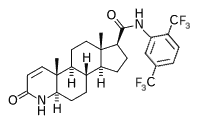For men with enlargement of the prostate gland, also called benign prostatic hyperplasia (BPH), combining two classes of drugs reduces the risk of significant worsening of symptoms and other complications by 66 percent, according to investigators at the University of Texas Southwestern Medical Center at Dallas.
BPH is a noncancerous enlargement of the prostate gland. It affects more than 50 percent of all men over 60 years of age in the U.S. Symptoms can include frequent or urgent need to urinate, slowing of the urinary stream, and hesitancy in urinating. With disease progression, recurrent urinary tract infections and urinary retention sometimes occur.
A five-year, multicenter study provided the first scientific evidence that combining the alpha blocker doxazosin (Cardura[R]) with the drug finasteride (Proscar[R]) was significantly more effective than using either treatment alone, said Dr. John McConnell, the university's executive vice president for health system affairs and lead author of the study. The clinical trial involved more than 3,000 men and 20 major medical centers across the U.S.
Using finasteride alone or combination therapy (but, surprisingly, not doxazosin) decreased the risk of acute urinary retention and the need for surgical intervention.
"Although we had predicted that combination therapy would be more effective than either drug alone, the magnitude of risk reduction was surprising," said Dr. McConnell.
These findings culminate three decades of research at UT Southwestern that began with Dr. Jean Wilson's discovery of the role of the enzyme 5-alpha reductase in BPH. The enzyme would later be the target for the drugs finasteride and dutasteride (Avodart[R]). The class of drugs inhibits the 5-alpha reductase enzyme, significantly lowering the level of the primary male hormone in the prostate, dihydrotestosterone (DHT), without affecting testosterone levels elsewhere in the body.
"Dr. Wilson's discovery set in motion a whole new era of treatment," Dr. McConnell said.
The trial showed that although doxazosin clearly contributed to symptom relief and reduced worsening of symptoms, the use of finasteride to shrink the prostate and prevent further prostate growth was required to reduce the long-term complications of the disease (i.e., urinary retention and the need for invasive therapy).
The double-blind study followed 3,047 men with BPH over 4.5 years. The men were randomly assigned to receive either doxazosin, finasteride, combination therapy, or a placebo. The combination of the two drugs delayed the clinical progression of BPH, compared with each drug individually in men with symptomatic BPH. Both drugs were well tolerated. Sexual function side effects occurred in approximately 10 percent of men taking finasteride. Dizziness, low blood pressure, and fatigue can occur with alpha blockers.
"A 66 percent reduction in the risk of anything in medicine is pretty substantial," said Dr. Claus Roehrborn, chairman of urology and a trial investigator at UT Southwestern. "This is good news. The fly in the ointment is that two tablets cost more than one, so there is a cost factor."
In June 2003, another study had shown that finasteride reduced the risk of prostate cancer by 25 percent.
Surgery is still the standard therapy for men with complications of BPH.
COPYRIGHT 2004 Vegetus Publications
COPYRIGHT 2005 Gale Group



